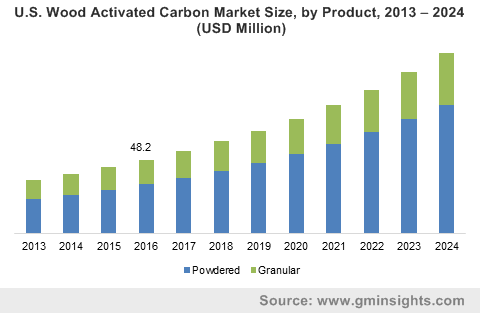Wood activated carbon market to garner extensive gains via heavy product deployment across the gas and water purification industry over 2017-2024
Publisher : Fractovia | Published Date : 2018-02-08Request Sample
Global sustainability trends can be aptly credited for the extensive growth of wood activated carbon market, given the rising levels of environmental pollution caused by thermal plants, refineries, manufacturing units and mines. The usage of wood activated carbon, deemed to be a perfect, environmentally friendly alternative for the removal of contaminants in air and water, has gained massive traction in recent times, impelling wood activated carbon market share. Not to mention, the product has found widespread applications ranging from simple municipal water purification to advanced technological applications such as the storage of natural gas adsorption and double layer capacitors. Incidentally, the product had been deployed in traditional herbal medicines, poison control and filtration as well, however, lately, it has been finding increased applications in health and beauty products, fueling wood activated charcoal industry trends.
U.S. Wood Activated Carbon Market Size, by Product, 2013 – 2024 (USD Million)

Wood activated carbon market can be classified among the regulatory-driven business spheres, since the product is made from raw materials like wood chips, coconut shell, fuel wood and peach – all of which abide by most of the standards set by authorities to avoid environmental pollution. The deployment of advanced technology has further stimulated wood activated carbon market share, since technologically developed products encompass a better pore structure and specific surface area, which increases adsorption capacity, improves filtration speed, lowers ash production, and creates more effective pore size distribution. Undeniably, driven by these enhanced characteristics, technologically advanced products have found widespread applications in automotive carbon cans, organic gas treatment, recycling of organic solvents, removal of impurities, and decolorization of lactic acid, citric acid, wine, spices and plant protein, driving wood activated carbon industry size.
It is vital to mention that wood activated carbon is a cost-effective means for gas purification, especially in industrial process gas steams where mercuric and organic contaminants are present in particles per million. Natural gas reserves also contain a percentage of the trace concentration of mercury, which needs to be eliminated immediately, especially during the production of liquified natural gas (LNG). This elimination holds specific importance, as mercury causes corrosion of aluminum heat exchangers that are involved in the LNG production process. With the rising demand for natural gases like LNG, it is overt that wood activated carbon market will accumulate massive gains in the ensuing years, as the product is liberally used in gas purification processes.
The application spectrum of wood activated carbon market in indeed immense. Wood activated carbon is often used as a desulphuriser in gases that contain Sulphur-like biogas streams, landfills and anaerobic digesters. In addition, the product is also used to remove trace amounts of lubrication oil from air streams to protect compressor parts, control ethylene and CO2 in fruit storage facilities to avert decay and over-ripening of fruits, and to absorb organic impurities during continuous hydrogen separation process by pressure swing adsorption (PSA). Endowed with such a humongous application landscape, wood activated carbon industry, no doubt, is slated to chart out a profitable growth map ahead.
The usage of wood activated carbon has been found to be most beneficial in the purification of industrial and domestic waste water. Activated carbon filters help to reduce the presence of volatile organic chemicals, herbicides and pesticides, besides reducing chlorine, benzene, radon, solvents and trihalomethane (THM) compounds present in water. Wood activated carbon has certain drawbacks in this regard and other technologies have undeniably proven to be more effective in removing metals and inorganic contamination from water. However, it is prudent to mention that wood activated carbon market has still captured a major percentage of its valuation from water purification applications. In fact, experts rate the usage of this technology to be the most cost-effective one till date, propelling the popularity matrix of wood activated carbon market.
Some of the most deterring forces for the wood activated carbon industry are the availability of alternate products and strict regulations being imposed on deforestation. However, the product is perpetually the most cost-effective means for air and gas purification as well as decolorization and deodorization, especially in the food and beverages industry. On these grounds, companies partaking in wood activated carbon industry have been striving to eliminate the plausible restraints of this business space, through the adoption of numerous tried-and-tested growth tactics. Not to mention, companies have also been rather active in conducting research and development programs to improve the performance of wood activated carbon. Given that the expanse of this sphere spans numerous geographies and the product deployment may have quite an impact on the environment, authorized government bodies have been attempting to enforce a favorable regulatory structure that may help improve the growth prospects of wood activated carbon market. In essence, wood activated carbon industry may emerge to be quite a lucrative business space by 2024, with a target revenue estimation of over USD 500 million.